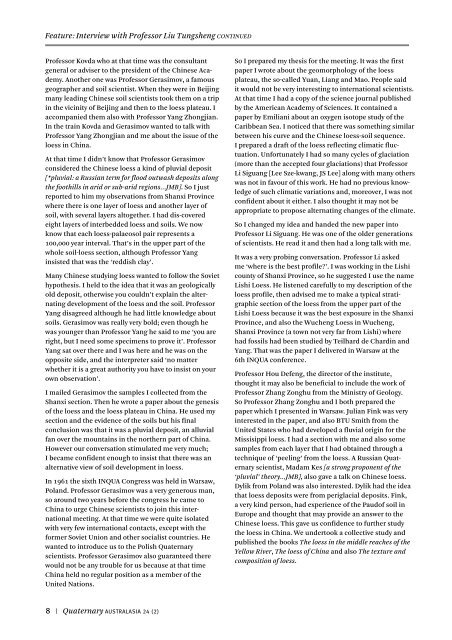QA_Vol 24_No 1_July 2007 - Australasian Quaternary Association
QA_Vol 24_No 1_July 2007 - Australasian Quaternary Association
QA_Vol 24_No 1_July 2007 - Australasian Quaternary Association
Create successful ePaper yourself
Turn your PDF publications into a flip-book with our unique Google optimized e-Paper software.
Feature: Interview with Professor Liu Tungsheng CONTINUEDProfessor Kovda who at that time was the consultantgeneral or adviser to the president of the Chinese Academy.Another one was Professor Gerasimov, a famousgeographer and soil scientist. When they were in Beijingmany leading Chinese soil scientists took them on a tripin the vicinity of Beijing and then to the loess plateau. Iaccompanied them also with Professor Yang Zhongjian.In the train Kovda and Gerasimov wanted to talk withProfessor Yang Zhongjian and me about the issue of theloess in China.At that time I didn’t know that Professor Gerasimovconsidered the Chinese loess a kind of pluvial deposit[*pluvial: a Russian term for flood outwash deposits alongthe foothills in arid or sub-arid regions...JMB]. So I justreported to him my observations from Shanxi Provincewhere there is one layer of loess and another layer ofsoil, with several layers altogether. I had dis-coveredeight layers of interbedded loess and soils. We nowknow that each loess-palaeosol pair represents a100,000 year interval. That’s in the upper part of thewhole soil-loess section, although Professor Yanginsisted that was the ‘reddish clay’.Many Chinese studying loess wanted to follow the Soviethypothesis. I held to the idea that it was an geologicallyold deposit, otherwise you couldn’t explain the alternatingdevelopment of the loess and the soil. ProfessorYang disagreed although he had little knowledge aboutsoils. Gerasimov was really very bold; even though hewas younger than Professor Yang he said to me ‘you areright, but I need some specimens to prove it’. ProfessorYang sat over there and I was here and he was on theopposite side, and the interpreter said ‘no matterwhether it is a great authority you have to insist on yourown observation’.I mailed Gerasimov the samples I collected from theShanxi section. Then he wrote a paper about the genesisof the loess and the loess plateau in China. He used mysection and the evidence of the soils but his finalconclusion was that it was a pluvial deposit, an alluvialfan over the mountains in the northern part of China.However our conversation stimulated me very much;I became confident enough to insist that there was analternative view of soil development in loess.In 1961 the sixth INQUA Congress was held in Warsaw,Poland. Professor Gerasimov was a very generous man,so around two years before the congress he came toChina to urge Chinese scientists to join this internationalmeeting. At that time we were quite isolatedwith very few international contacts, except with theformer Soviet Union and other socialist countries. Hewanted to introduce us to the Polish <strong>Quaternary</strong>scientists. Professor Gerasimov also guaranteed therewould not be any trouble for us because at that timeChina held no regular position as a member of theUnited Nations.So I prepared my thesis for the meeting. It was the firstpaper I wrote about the geomorphology of the loessplateau, the so-called Yuan, Liang and Mao. People saidit would not be very interesting to international scientists.At that time I had a copy of the science journal publishedby the American Academy of Sciences. It contained apaper by Emiliani about an oxygen isotope study of theCaribbean Sea. I noticed that there was something similarbetween his curve and the Chinese loess-soil sequence.I prepared a draft of the loess reflecting climatic fluctuation.Unfortunately I had so many cycles of glaciation(more than the accepted four glaciations) that ProfessorLi Siguang [Lee Sze-kwang, JS Lee] along with many otherswas not in favour of this work. He had no previous knowledgeof such climatic variations and, moreover, I was notconfident about it either. I also thought it may not beappropriate to propose alternating changes of the climate.So I changed my idea and handed the new paper intoProfessor Li Siguang. He was one of the older generationsof scientists. He read it and then had a long talk with me.It was a very probing conversation. Professor Li askedme ‘where is the best profile?’. I was working in the Lishicounty of Shanxi Province, so he suggested I use the nameLishi Loess. He listened carefully to my description of theloess profile, then advised me to make a typical stratigraphicsection of the loess from the upper part of theLishi Loess because it was the best exposure in the ShanxiProvince, and also the Wucheng Loess in Wucheng,Shanxi Province (a town not very far from Lishi) wherehad fossils had been studied by Teilhard de Chardin andYang. That was the paper I delivered in Warsaw at the6th INQUA conference.Professor Hou Defeng, the director of the institute,thought it may also be beneficial to include the work ofProfessor Zhang Zonghu from the Ministry of Geology.So Professor Zhang Zonghu and I both prepared thepaper which I presented in Warsaw. Julian Fink was veryinterested in the paper, and also BTU Smith from theUnited States who had developed a fluvial origin for theMissisippi loess. I had a section with me and also somesamples from each layer that I had obtained through atechnique of ‘peeling’ from the loess. A Russian <strong>Quaternary</strong>scientist, Madam Kes [a strong proponent of the‘pluvial’ theory...JMB], also gave a talk on Chinese loess.Dylik from Poland was also interested. Dylik had the ideathat loess deposits were from periglacial deposits. Fink,a very kind person, had experience of the Paudof soil inEurope and thought that may provide an answer to theChinese loess. This gave us confidence to further studythe loess in China. We undertook a collective study andpublished the books The loess in the middle reaches of theYellow River, The loess of China and also The texture andcomposition of loess.8 | <strong>Quaternary</strong> AUSTRALASIA <strong>24</strong> (2)


